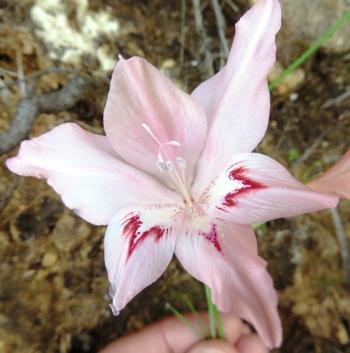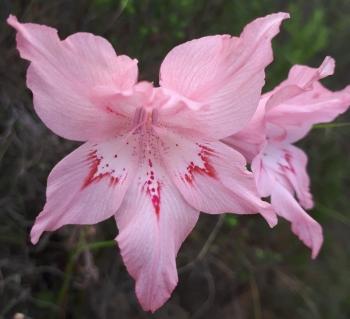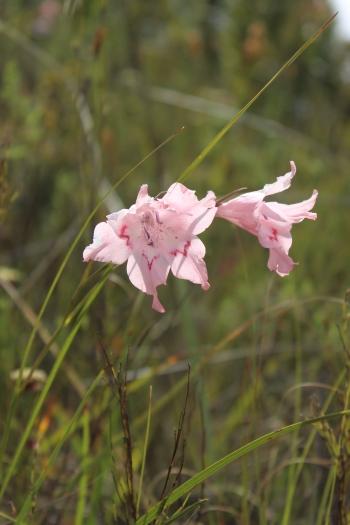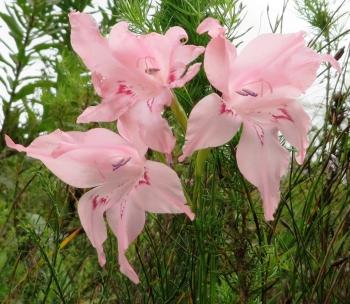Gladiolus virgatus
Gladiolus virgatus Goldblatt & J.C.Manning
Family: Iridaceae
Common names: Helderberg Painted Lady
Introduction
Lovers of the outdoors visiting Nature Reserves in the Boland mountains of the Western Cape, will often be enthralled by cheerful displays of pretty pink gladioli appearing during the spring months. But, not all gladioli are equal and some species are less common than others. Gladiolus virgatus is one such plant, only having been recorded thus far from the Du Toit’s Kloof Mountains, and the Helderberg area, near Somerset West in the Western Cape.

Description
Description
Gladiolus virgatus is an extremely pretty variety of the pink gladioli, flowering in spring, from September to early November. The corm is globose with woody to coarsely fibrous tunics. Plants are between 300–600 mm high, and as indicated by the species epithet, have slender, arching and willowy unbranched stems, with 4 linear leaves. It appears specimens from the Du Toit’s Kloof Mountains are smaller than those from the Helderberg area. Of the leaves, the lower 2 are the longest and basal, sheathing to about midway up the stem and extending to just beyond the apex of the spike, whereas the remainder are shorter and sheathing for half their length. Characteristically, leaf blades are linear with thickened margins and a slightly raised midrib.

The unscented flowers, borne in a 2–4(up to 6)-flowered spike, are dark to pale pink or almost white, with spear-shaped whitish median streaks, edged with darker V-shaped markings and pink speckles in the throat, on the lower tepals. The perianth tube is relatively long, 22–27 mm, and slightly shorter than the bracts. The dorsal tepal is largest, 30–37 mm long, arching over the stamens, and the lower tepals are a little shorter and arching forward. The floral bracts are characteristically ridged, green or flushed with purple and between 30 to 50 mm long.

Conservation Status
Status
The current South African Red List status is given as Least Concern (LC), however, given the restricted range of this species in the wild, this may come under review.

Distribution and habitat
Distribution description
This is a South African endemic restricted to 2 known localities in the Du Toit’s Kloof Mountains and the Helderberg, near Somerset West. The preferred habitat is on mountain slopes in boulder-strewn clay soils, derived from shale.

Derivation of name and historical aspects
History
The genus name Gladiolus stems from the Latin diminutive for a sword, gladius, relating to the shape of the leaves, whereas virgatus describes the willowy nature of the slender arching stems.
The earliest records of this species date back to 1907 when flowers bought from Cape Town flower sellers were brought to the Bolus Herbarium and preserved, and a further specimen which was obtained in 1914 at the Stellenbosch Wild Flower Show from an unknown location. Another early specimen was collected in the Helderberg area in 1921 and then it was recorded again in 1943 independently collected by a botanist, namely Elsie Esterhuyse and a retired forester, R.N. Parker. These and other collections were initially identified as the similar, but shorter-tubed species Gladiolus blommesteinii.
Therefore, even though Gladiolus virgatus had been collected since the beginning of the last century, it was only formally recognised as a new species, when Peter Goldblatt and John Manning revised the genus Gladiolus, in 1993 and were made aware of an unusual pink gladiolus in the Helderberg found by P.A Runnals, while she was collecting plants for compiling a flora for the Helderberg Nature Reserve. Goldblatt and Manning then described Gladiolus virgatus from a specimen gathered in the Du Toit’s Kloof Mountains in 1949 by the legendary Elsie Esterhuyse, who had noted the differences in markings on the flowers from the then known Gladiolus blommesteinii.

Ecology
Ecology
Having a relatively long tube, Gladiolus virgatus is adapted to pollination by long-tongued flies. Horseflies (Philoliche rostrata) have been observed visiting the flowers. Gladiolus seeds have wings and are thus dispersed by wind.

Uses
Use
As this is such an uncommon species, there are no known uses.

Growing Gladiolus virgatus
Grow
As this is one of the less common species of Gladiolus, it is not available commercially, and it is also one of the more difficult species to cultivate. This is a winter-growing species and will grow in acid sand with sifted compost. Corms must be kept completely dry during the summer months (pers. Com. G. Duncan). Winter-growing Gladiolus plants can be grown from seeds or corms, which must be sown or planted in autumn, in well-drained soil.
References
- Cholo, F. 2006. Gladiolus virgatus Goldblatt & J.C.Manning. National Assessment: Red List of South African plants version 2017.1. Accessed on 2017/11/17.
- Du Plessis, N. & Duncan, G. 1989. Bulbous plants of southern Africa: a guide to their cultivation and propagation. Tafelberg, Cape Town.
- Goldblatt, P. & Manning, J. 1998. Gladiolus in southern Africa. Fernwood Press, Vlaeberg, Cape Town.
- Goldblatt, P. & Manning, J. 2000. Cape Plants. A conspectus of the Cape flora of South Africa. Strelitzia 9. National Botanical Institute, Pretoria & Missouri Botanical Garden, Missouri.
- Manning, J., Goldblatt, P. & Snijman, D. 2002. The color encyclopedia of Cape bulbs. Timber Press, Cambridge.
Credits
Gigi Laidler
Custodians of Rare and Endangered Wildflowers (CREW)
January 2018
Acknowledgements: Images courtesy of I. Ebrahim and H. Pickering
Plant Attributes:
Plant Type: Bulb
SA Distribution: Western Cape
Soil type: Sandy, Clay
Flowering season: Spring
PH: Acid
Flower colour: Pink
Aspect: Full Sun
Gardening skill: Challenging
Special Features:
Horticultural zones







Rate this article
Article well written and informative
Rate this plant
Is this an interesting plant?
Login to add your Comment
Back to topNot registered yet? Click here to register.